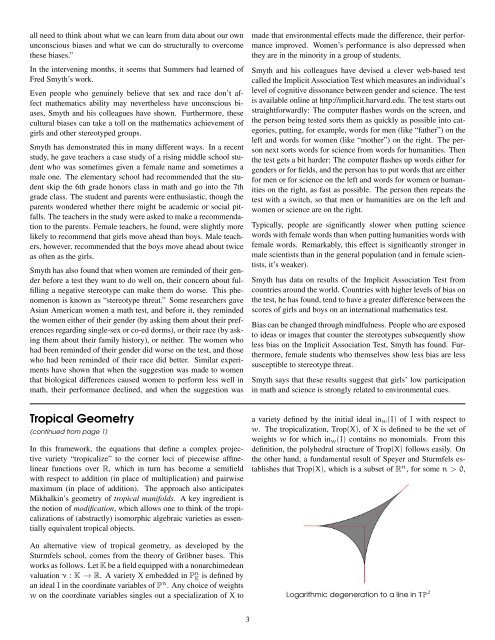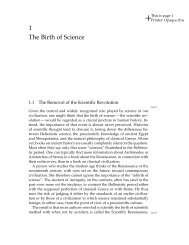Create successful ePaper yourself
Turn your PDF publications into a flip-book with our unique Google optimized e-Paper software.
all need to think about what we can learn from data about our own<br />
unconscious biases and what we can do structurally to overcome<br />
these biases.”<br />
In the intervening months, it seems that Summers had learned of<br />
Fred Smyth’s work.<br />
Even people who genuinely believe that sex and race don’t affect<br />
mathematics ability may nevertheless have unconscious biases,<br />
Smyth and his colleagues have shown. Furthermore, these<br />
cultural biases can take a toll on the mathematics achievement of<br />
girls and other stereotyped groups.<br />
Smyth has demonstrated this in many different ways. In a recent<br />
study, he gave teachers a case study of a rising middle school student<br />
who was sometimes given a female name and sometimes a<br />
male one. The elementary school had recommended that the student<br />
skip the 6th grade honors class in math and go into the 7th<br />
grade class. The student and parents were enthusiastic, though the<br />
parents wondered whether there might be academic or social pitfalls.<br />
The teachers in the study were asked to make a recommendation<br />
to the parents. Female teachers, he found, were slightly more<br />
likely to recommend that girls move ahead than boys. Male teachers,<br />
however, recommended that the boys move ahead about twice<br />
as often as the girls.<br />
Smyth has also found that when women are reminded of their gender<br />
before a test they want to do well on, their concern about fulfilling<br />
a negative stereotype can make them do worse. This phenomenon<br />
is known as “stereotype threat.” Some researchers gave<br />
Asian American women a math test, and before it, they reminded<br />
the women either of their gender (by asking them about their preferences<br />
regarding single-sex or co-ed dorms), or their race (by asking<br />
them about their family history), or neither. The women who<br />
had been reminded of their gender did worse on the test, and those<br />
who had been reminded of their race did better. Similar experiments<br />
have shown that when the suggestion was made to women<br />
that biological differences caused women to perform less well in<br />
math, their performance declined, and when the suggestion was<br />
Tropical Geometry<br />
(continued from page 1)<br />
In this framework, the equations that define a complex projective<br />
variety “tropicalize” to the corner loci of piecewise affinelinear<br />
functions over R, which in turn has become a semifield<br />
with respect to addition (in place of multiplication) and pairwise<br />
maximum (in place of addition). The approach also anticipates<br />
Mikhalkin’s geometry of tropical manifolds. A key ingredient is<br />
the notion of modification, which allows one to think of the tropicalizations<br />
of (abstractly) isomorphic algebraic varieties as essentially<br />
equivalent tropical objects.<br />
An alternative view of tropical geometry, as developed by the<br />
Sturmfels school, comes from the theory of Gröbner bases. This<br />
works as follows. Let K be a field equipped with a nonarchimedean<br />
valuation ν : K → R. A variety X embedded in Pn K is defined by<br />
an ideal I in the coordinate variables of Pn . Any choice of weights<br />
w on the coordinate variables singles out a specialization of X to<br />
3<br />
made that environmental effects made the difference, their performance<br />
improved. Women’s performance is also depressed when<br />
they are in the minority in a group of students.<br />
Smyth and his colleagues have devised a clever web-based test<br />
called the Implicit Association Test which measures an individual’s<br />
level of cognitive dissonance between gender and science. The test<br />
is available online at http://implicit.harvard.edu. The test starts out<br />
straightforwardly: The computer flashes words on the screen, and<br />
the person being tested sorts them as quickly as possible into categories,<br />
putting, for example, words for men (like “father”) on the<br />
left and words for women (like “mother”) on the right. The person<br />
next sorts words for science from words for humanities. Then<br />
the test gets a bit harder: The computer flashes up words either for<br />
genders or for fields, and the person has to put words that are either<br />
for men or for science on the left and words for women or humanities<br />
on the right, as fast as possible. The person then repeats the<br />
test with a switch, so that men or humanities are on the left and<br />
women or science are on the right.<br />
Typically, people are significantly slower when putting science<br />
words with female words than when putting humanities words with<br />
female words. Remarkably, this effect is significantly stronger in<br />
male scientists than in the general population (and in female scientists,<br />
it’s weaker).<br />
Smyth has data on results of the Implicit Association Test from<br />
countries around the world. Countries with higher levels of bias on<br />
the test, he has found, tend to have a greater difference between the<br />
scores of girls and boys on an international mathematics test.<br />
Bias can be changed through mindfulness. People who are exposed<br />
to ideas or images that counter the stereotypes subsequently show<br />
less bias on the Implicit Association Test, Smyth has found. Furthermore,<br />
female students who themselves show less bias are less<br />
susceptible to stereotype threat.<br />
Smyth says that these results suggest that girls’ low participation<br />
in math and science is strongly related to environmental cues.<br />
a variety defined by the initial ideal inw(I) of I with respect to<br />
w. The tropicalization, Trop(X), of X is defined to be the set of<br />
weights w for which inw(I) contains no monomials. From this<br />
definition, the polyhedral structure of Trop(X) follows easily. On<br />
the other hand, a fundamental result of Speyer and Sturmfels establishes<br />
that Trop(X), which is a subset of R n , for some n > 0,<br />
Logarithmic degeneration to a line in TP 2










